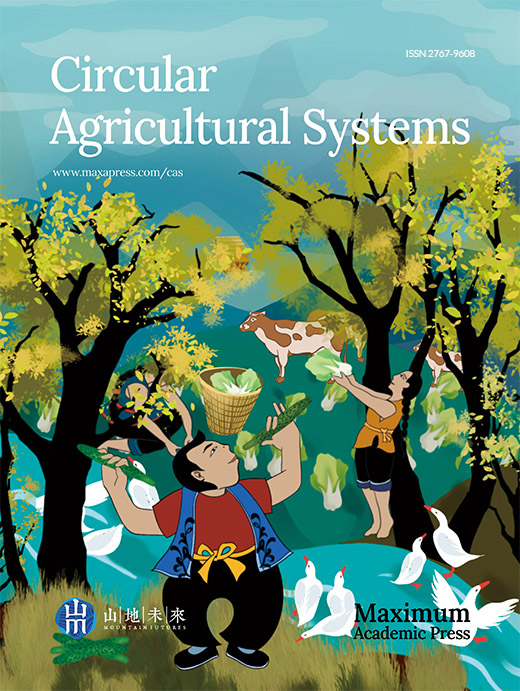-
Coconut (Cocos nucifera L.), is a palm listed under the Arecaceae family and is a predominant agricultural crop in tropical regions globally. The 'Tree of Life' is a term used worldwide to describe the utility of all parts of the coconut tree (as a source of drink, food, oil, construction materials, fiber, charcoal, etc.). Asia, Oceania, West Indies, and some parts of the African, and American regions are considered prevalent coconut-growing regions. The majority of coconut production however comes from Asia and the Pacific regions[1]. Demand for coconut nuts and related products. is steadily increasing in the international market.
The Sri Lankan coconut industry is expanding rapidly, with nearly around 400,000 hectares across the island giving 3,086 million nut yields in 2019, making it the world's fourth-largest producer[2]. In Sri Lanka, it is popular as 'Kapruka', which has become an essential component in Sri Lankan culture. Significant large-scale coconut plantations, covering more than 57% of arable coconut farm land, occur in the 'coconut triangle' of Sri Lanka, including the administrative districts of Kurunegala, Gampaha, and Puttalam. Furthermore, the Southern province, known as the 'mini-coconut triangle', contains around 12% of coconut cultivating land[3]. Although coconut can be grown in most of the areas on the island below the elevation level of 750 m amsl, coastal areas in the wet and intermediate zones in Sri Lanka with high humidity, 1,250–2,500 mm average mean annual precipitation and 27 to 29 °C average annual temperature are the best[2,4] .
Long-term coconut cultivation will degrade soil quality due to less adoption of recommended practices such as fertilization, soil, and moisture conservation methods leading to less coconut yield[5,6]. Most of the Sri Lankan agricultural soils show deficiencies in available nutrient content including nitrogen, potassium, phosphorus, boron, sulfur, calcium, and magnesium, but high levels of iron[7]. Since the majority of local coconut-growing soils are sandy, such incidences can occur regularly[1]. Other than that, climate changes in coconut growing areas, poor agronomic practices, and biotic and abiotic stresses (pest, diseases, drought, and heat stresses) are key factors influencing the nut yield[8]. Strategic priorities should be taken to address these issues while increasing coconut productivity. Cover cropping is one of the most rewarding and time-tested farming solutions that can be easily utilised to address to some of above mentioned issues, mainly related to infertile soil and less productivity in coconut cultivation[4,9].
Cover crops are the variety of plant species used to cover the soil surface[10]. It is a live plant, established before or after the cash crop and has a shorter life cycle than the main crop[11]. According to some reports, crops from Poaceae and Fabaceae families such as cereals, grasses, and legumes and crops from the Brassicaceae family have high potential to be a cover crops globally[6,12]. Depending on the climatic conditions in Sri Lanka, legumes, fodder and pasture grasses have been identified as commonly used and trending cover crops, especially for coconut cultivations (Table 1; Fig. 1).
Family Scientific name Common name Life span Growing habit Fabaceae Pueraria phaseoloides Puero Perennial Climber or creeper Calopogonium mucunoides Calopo Perennial Climber or creeper Centrosema pubescens Centro Perennial Climber or creeper Macroptilium atropurpureum Siratro Perennial Climber or creeper Mucuna spp. Mucuna Perennial Climber or creeper Gliricidia sepium Gliricidia Perennial Tree Gliricidia maculata Gliricidia Perennial Tree Leucaena leucocephala Ipil-ipil Perennial Tree Tithonia diversifolia Wild sunflower Perennial Shrub Crotalaria juncea Sunn hemp Annual Herb Poaceae Brachiaria brizantha Signal grass Perennial Herb Brachiaria ruziziensis Ruzi grass Perennial Herb Brachiaria milliformis Cori grass Perennial Herb Zea mays Fodder-maize Annual Herb 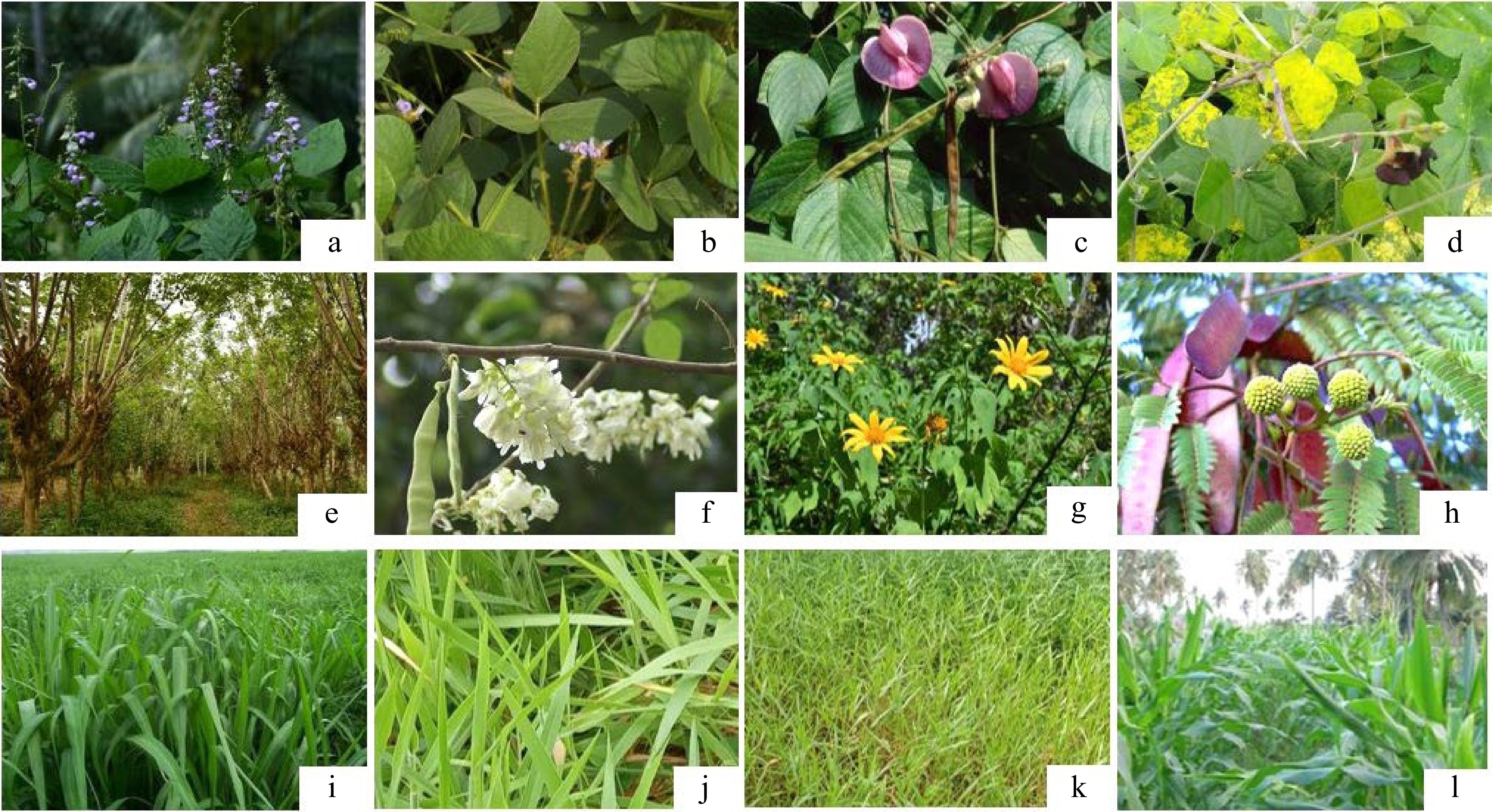
Figure 1.
Widely cultivated cover crop species in Sri Lanka. (a) Pueraria phaseoloides Roxb. (b) Calopogonium mucunoides. (c) Centrosema pubescens. (d) Macroptilium atropurpureum. (e) Gliricidia sepium. (f) Gliricidia maculata. (g) Tithonia diversifolia. (h) Leucaena leucocephala. (i) Brachiaria brizantha. (j) Brachiaria ruziziensis. (k) Brachiaria milliformis. (l) Zea mays.
The objectives of this review are to review and understand the current state of knowledge on: (1) benefits of cover cropping in coconut plantations; and (2) planting and management of cover crops in coconut plantations for optimization of the national coconut productivity and land productivity through cover cropping.
-
Generally, growing cover crops is one of the most effective and cost-effective ways to control pests, diseases, nematode incidence, and weeds in the agricultural field[16]. As a result, there will be less dependence on chemicals, such as pesticides, herbicides, and insecticides, a reduction in production costs, profit maximization, and food safety and environmental safety[17,18]. Cover crops can suppress weeds in the fields which compete for resources such as sunlight and nutrients, modifying soil temperature and moisture by producing allelopathic exudates, smothering, competition and modifying seed environments[19,20]. Allelochemicals are the biochemical of a particular plant that has an ability to stimulate or inhibit the growth of another plant. Since those plants behave as a mulch on the ground surface or act as a smother plant, the amount of light that reaches the soil can be easily controlled and heat absorption will be prevented[21]. Weed seeds are unable to germinate as a result of these conditions. But, the effectiveness of weed suppression varies with the cover crop species (Table 2).
Table 2. Weed suppression percentage by different cover crop species in a cotton field[16].
Cover crop species Suppression % of
grassy weedsSuppression % of
broad-leaf weedsCalopogonium mucunoides 4 96 Mucuna spp. 7 93 Crotalaria juncea 9 91 No cover cropped land 19 81 In the Sri Lankan context, it has been demonstrated that cover cropping (with for example, Pueraria phaseoloides) has similar effects as herbicides (glyphosate) for controlling weeds and is more effective than mechanical weed control methods such as harrowing, slashing, and ploughing in coconut plantations[22,23] (Fig. 2).
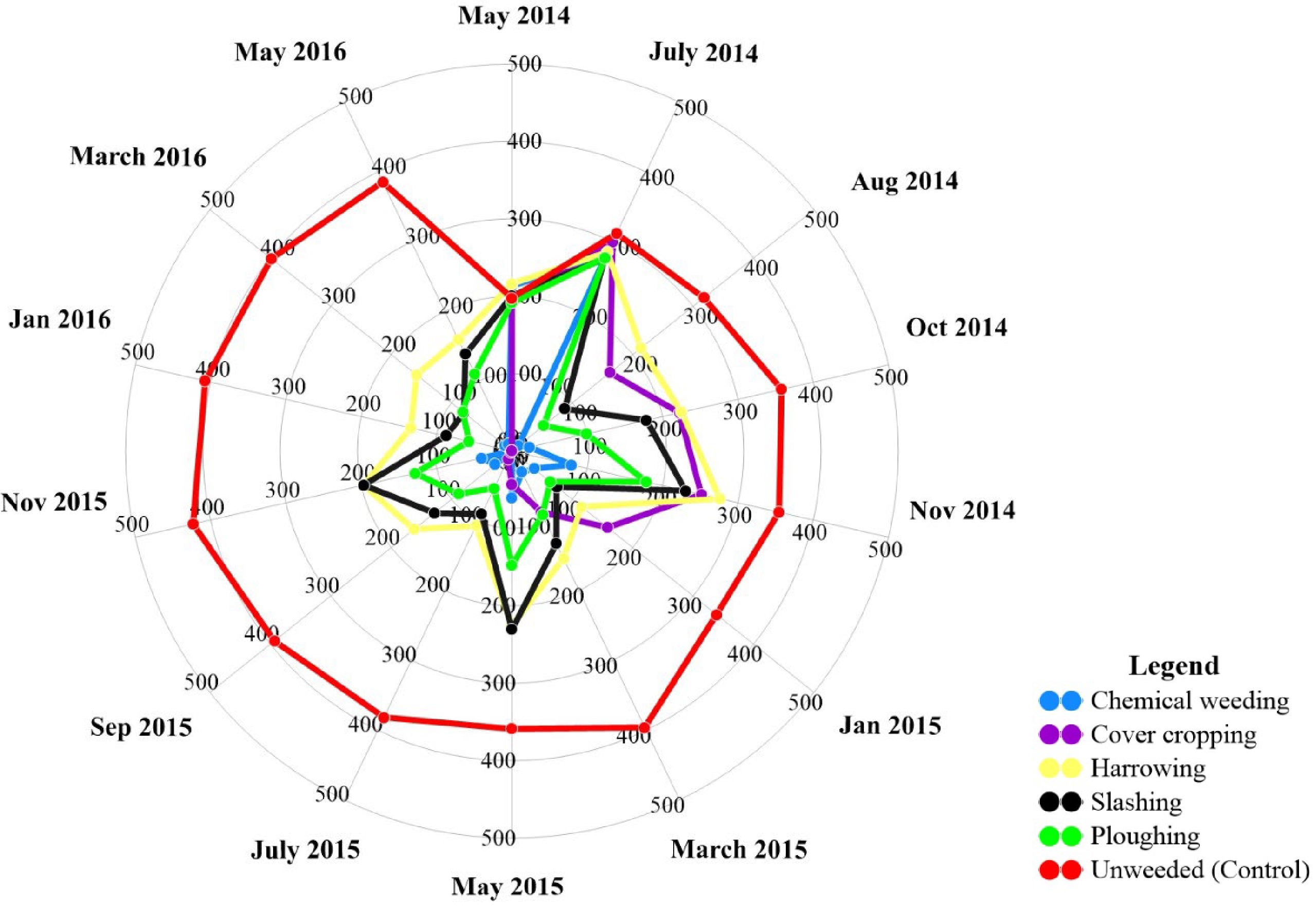
Figure 2.
Comparison of different weed control methods in coconut plantations[22].
Growing cover crops with coconut palms may extend the length of a crop rotation for breaking the regular pest cycles, modify the soil structure for enhancing the soil health, act as a barrier for protecting soil cover from other pests and pathogen carriers such as farm equipment, labor, and other crop materials and it also increases the colonization of non-harmful, pathogen suppressive fungi which results in the control of pests and pathogens[16]. Moreover, the flowering cover crop species attract predatory and beneficial insects including pollinators, lacewings, ladybirds, hoverflies, and parasitic wasps to the field due to the provision of nectar and pollen[16]. This will promote pollination activities of crops in addition to suppressing diseases and pests occurrences. Cover crops take two routes to protect the main crop from diseases and nematode activity. The first is the production of toxic elements such as glucosinolates and the bio-fumigation process, both of which can have a direct impact on pathogens[24]. The second is the provision of organic substrates to ensure better growth of beneficial microbes on the field, particularly bacteria, nonpathogenic Fusarium species, Actinomycetes, and Streptomyces communities[16].
The impact of cover cropping on soil characteristics
-
Cover crops improve soil's chemical, physical, and biological properties[6,25,26]; but not all plants are equally effective. These crops act as a barrier to nutrient leaching; depending on the nutrient type[27]. Generally, cover cropping is an effective practice to enhance soil nutrient storage[14]. For example, cover cropping can return 2.1−4.3 Mg ha−1 of carbon and 0.11−0.31 Mg ha−1 of nitrogen per annum[28]. It is more effective at controlling the loss of sediment-associated nutrients like nitrogen than nutrients that are leached by dissolving in runoff water like soluble phosphorus[27]. Cover crops that have a deep rooting system may have better nitrogen use efficiency, nitrogen scavenging abilities, and lesser nitrogen leaching[29]. According to previous findings, the average nitrate leaching reduction due to non-legume cover crops was about 70%, while there is a 23% reduction with legume cover crops[30]. Therefore, this practice has been proposed as a better solution for avoiding surface and groundwater pollution because it reduces nutrient losses from agricultural fields. Thereby, it helps to maintain better water quality and conditions, which is considered a major challenge for modern agriculture[25].
Integrating living ground cover into farmland can change the soil structure and conditions, providing better crop anchorage. This may improve the movement of water through soil, modify soil temperature, minimizing water runoff and soil erosion, due to variable rooting properties, which include length, distribution patterns, densities, radius, thickness, and morphological characteristics[27]. Aside from that, it affects soil salinity, sodicity, and ion exchange capacity[10]. Formation of allelopathic compounds, reduction of damage to the soil surface mainly due to rain and wind, modifying water infiltration and increasing both soil organic carbon content and water-extractable organic carbon level will enhance the soil aggregation formation and its’ stability[10,18,31]. When comparing fibrous-rooted cover crops with tap root plants, grasses like B. brizantha form a soil which has higher mean weight diameter (1.78 mm) over legumes like P. phaseoloides indicating greater aggregate formation and better aeration in the coconut root zone[6]. As a result of that, water availability at field capacity level in the root zone (0−11 cm depth) is greater (32.98%) than in deep soil layers (11−42 cm) (28.50%) in coconut plantations with grass cover. These cover crops assist in minimizing soil evaporation, conserve soil moisture, and increase water retention concerning field capacity with plant available water[32]. Furthermore, cover cropping helps with carbon sequestration, thereby reducing the global climate change effect[9]. It was proven that the annual reduction of sediment erosion by cover crops like Stellaria media, Poa compressa, and Bromus tectorum is about 87%, 95%, and 96% respectively compared to bare land[33].
Ground cover vegetation can benefit the soil microbial fauna (bacteria and fungi) by increasing abundance (27%), diversity (22%), and activity (2.5%)[6,34]. This could occur as a result of: 1) an increase in the diversity of plants in the field[35]; 2) the influence of root exudates made with carbon-rich compounds[36,37]; 3) changing soil moisture conditions[38]; 4) presence diversity of plant functional groups, such as C3 grasses, C4 grasses, legumes, and non-legumes[35], and 5) using native species as cover crops because they are easily adaptable to the natural environment[35]. For example, growing leguminous cover crops (i.e. P. phaseoloides, C. pubescens) can enhance the microbial biomass in terms of carbon, nitrogen, and phosphorus by 61%, 51%, and 50% respectively compared to no-cover cropped coconut plantations[28]. As described by Senarathne et al., incorporating T. diversifolia into adult coconut palm manure cycles would increase the microbial activity in both wet and dry zones in the long term (Table 3)[15].
Table 3. Variation of microbial activity on T. diversifolia added coconut land[15].
Zone in Sri Lanka Microbial activity (mg day−1) 2009 2010 2011 2012 Walpita Research Station
(Wet zone)72.54 76.89 88.36 96.74 Potthukulama Research Station
(Dry zone)48.62 55.22 70.36 68.94 Coconut is a plantation crop that is extremely sensitive to low moisture levels in the soil[4]. Furthermore, it reduces bulk density in coconut land, facilitating good root penetration and better fauna activities[4] (Table 4).
Table 4. Effect of cover cropping on soil bulk density and soil moisture content[40].
Treatment Soil bulk density
(g cm−3)Soil moisture content
(%)2010 2011 2012 2010 2011 2012 Coconut with G. sepium 1.49 1.42 1.36 1.44 4.56 2.98 Coconut with P. phaseoloides 1.36 1.32 1.24 3.27 6.78 5.68 Coconut with no cover crop 1.68 1.73 1.69 1.27 2.98 1.58 The influence of ground cover on the above-mentioned properties will differ with field environmental factors including soil characteristics such as soil texture, soil type, soil depth, cover crop frequency, and species, tillage pattern in the field, and crop rotation[33]. However, some studies reported that the cultivation of these plants in agricultural land has a negligible influence on some soil physical parameters (i.e. pore size distribution, field capacity, and permanent wilting point) [26]. This indicates the need for more research on what has an overall effect of all these influences, the coconut yield will be increased with well-maintained cover cropping (Table 5).
Table 5. Effect of cover cropping on average nut yield[40].
Treatment Nut yield (nuts/palm/year) 2009 2010 2011 2012 Coconut with G. sepium 53 33 68 63 Coconut with P. phaseoloides 51 42 71 68 Coconut with no cover crop 43 32 42 43 According to previous studies, cover cropping is important as a moisture conservation method because of minimizing transpiration and evaporation of water loss from bare soil[1,39] (Table 6). Considering several factors, growing legume cover crops has gathered more attention than Poaceae family ground cover. Higher nutritional composition and greater nutrient transferring ability in leguminous ground cover species has greater positive influence on the soil surface and subsoil chemical properties than others (Fig. 3 & 4). Instead of synthetic fertilizer, the application of 30 kg of Gliricidia sepium or Leucaena leucocephala fresh leaves for a coconut palm can supply 100% of the annual nitrogen requirement and 20% of both annual phosphorus and potassium requirements of an adult coconut palm[1]. In addition to that, it can fix atmospheric nitrogen, which helps to raise soil nitrogen levels. C/N ratio which is used as an indicator for measuring decomposition rate is comparatively lower in legume plant residuals than non-legume types[41]. It facilitates the fast decomposition ability of legume cover crops. According to the literature, legumes are able to create strong and active rhizosphere with diverted macro and microorganisms due to secretion of higher amino nitrogen concentration[36].
Table 6. Summarization of cost and benefits of cover cropping systems.
Cost Benefits Outputs Outcomes Cost for planting materials Suppressing weeds Enhancing plant growth Increased cost for machinery and other equipment
• Tractors
• Disc-harrowers
• Mammoties
• KnivesModifying soil hydraulic properties
• Enhancing the water infiltration
• Soil moisture conservation
• Reduce soil temperatureLess dependency on chemicals such as
• Pesticides
• Weedicides
• Insecticides
• Synthetic fertilizersIncreased cost for labor for field
activities planting land preparation
fertilization pruning IrrigationIncreasing soil chemical properties
• Supplying nutrients
• Supplying organic matter
• Nitrogen fixationProtect the biodiversity by maximizing the ecosystem services Increased cost for farming practices
• Fertilizing
• IrrigationThe attraction of predators and beneficial insects
such as pollinators, hoverflies, lacewings, ladybirds, parasitic waspsMinimizing land, water, and environmental pollution Knowledge of cover crop species and management practices Minimizing pest and diseases incidence Reduce nutrient leaching Modifying soil physical properties Control sediment and water erosion Habitat for flora and fauna Flood control Modifying soil biological properties Comfort livelihood Source of food, feeding materials, fuel, medicinal and pharmaceutical products, and genetic materials Increasing the resource utilization in the farm field Carbon sequestration Increasing farmers' income Reducing the cost of production Chance for animal husbandry on coconut plantations Less dependency on main cash crop Source for food; milk, meat Reducing the global climate changes 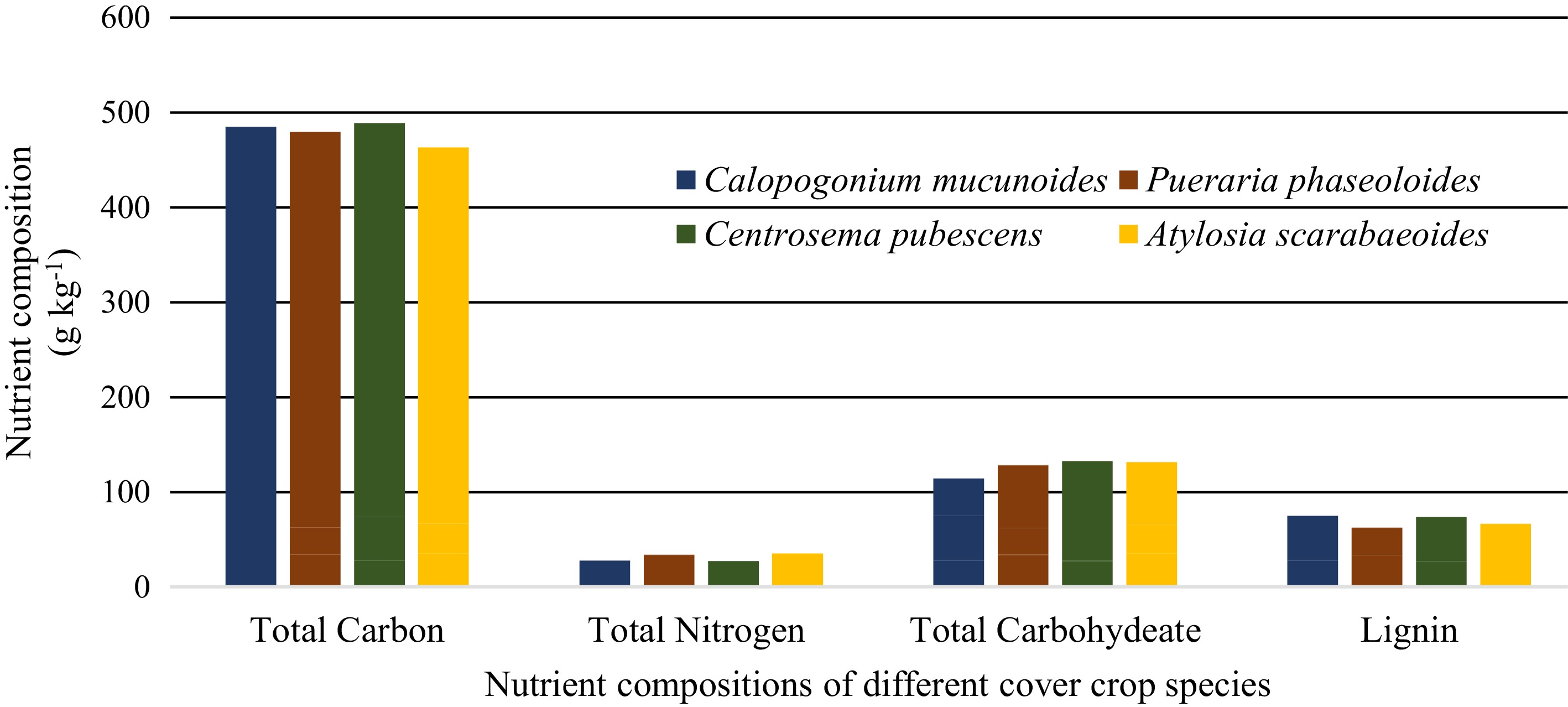
Figure 3.
Comparison of nutrient composition of different legume cover crops[28].
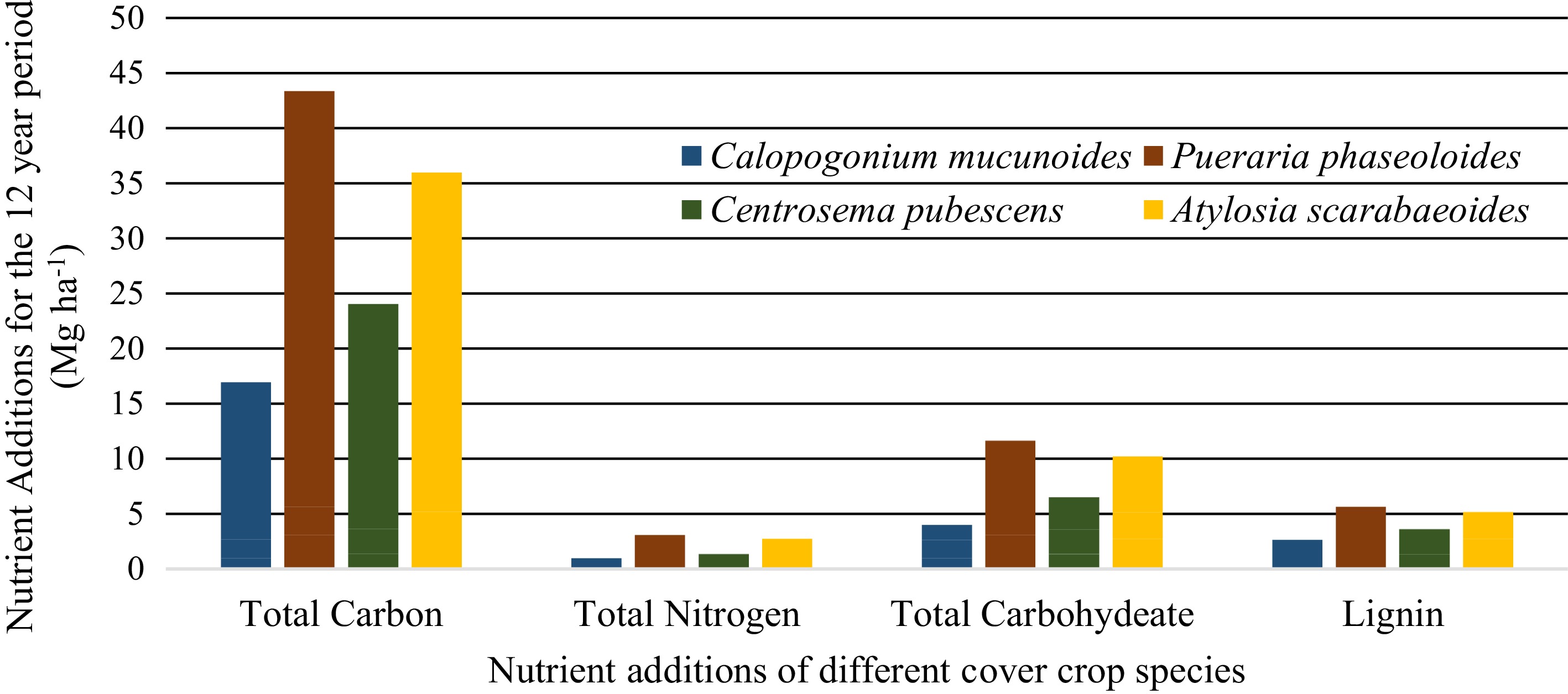
Figure 4.
Comparison of nutrient additions of different legume cover crops for the 12 y period[28].
Suitability of cover crops as food and feeding materials
-
Cover crops are often used for rotational grazing of farm animals[42]. These types of cover crops are known as 'dual purpose cover crops'[43]. Coconut farmers will be able to supplement their income because they will have an additional source of animal-based products like milk, meat, and manure to sell[9]. According to some case studies, a significant area under coconut plantations is home to a variety of cattle, including clean, cross-bred, and indigenous cattle[44]. This suggests that fodder species used as cover crops in coconut plantations is a viable option where livestock integration is maintained. Therefore, it is important to consider the forage quality including digestibility, nutrient concentration, amount of dietary fiber or plant cell wall concentration (low lignin content) of ground cover that are to be used as fodder material[45,46]. As a result, before using it as a feeding material, better identification and quantification of the chemical composition of species is required. Fodder grasses similar to Brachiaria brizantha, are preferred over some conventional fodder materials such as Napier (Pennisetum purpureum) and Guinea grasses (Panicum maximum) due to their higher palatability and resistance toward biotic and abiotic stresses[47]. Furthermore, the suitability and practicability of Coimbatore-3 or Hybrid Napier (CO-3), the hybrid of Pennisetum perpureum × Pennisetum americarnum, multi-cut hybrid fodder sorghum, and wild sorghum (Sorghum bicolor L. Moench) have been locally identified[13]. Cover crops like Mucuna spp., Vigna unguiculata, Vigna radiate, and Pennisetum americanum give edible seeds, leaves, and flowers consumed by humans.
Other benefits of cover crops
-
Certain ecosystem functions can be negatively affected by continuous farming practices. As an overall effect, cover crops help to maintain many ecosystem services such as provisioning, regulating, and supporting categories that can sustain the life of living organisms on earth[25]. Other than the above-mentioned benefits from cover crops, they are sources of economically important products such as medicinal, pharmaceutical, and valued nutritional products, fiber and fuel, and a source of genetic materials for the production of genetically improved varieties and edible materials such as grains[48]. Cover crops also aid in mitigating climatic changes by controlling the outflow of greenhouse gasses and regulating environmental factors like temperature, global warming, and precipitation[49]. According to that, the greenhouse mitigating capacity of legume cover crops (≈135 g CO2 e/m2/year) is higher than non-legume cover crops (≈116 g CO2 e/m2/year). When compared with no-cover cropped land, it is less than 100−150 g CO2 e/m2/year[10]. Moreover, establishing cover crops with cash crops helps to enhance both above-ground and below-ground biodiversity and species richness in the field[10]. Considering all those effects, it might be stated that ground cover increase the crop yield both directly and indirectly. The benefits and costs of cover crops are summarized below (Table 6).
-
Cover crops are primarily recommended for perennial crops with a wider row spacing, and the area between cash crop rows is used for establishing ground cover[10]. Even though cover crops can be allowed to grow within the manure cycle in the adult palms, in the seedling stage, there should be at least a 2 m radius area between the palm root base and growing cover crops[50]. The performance of these cover crops in terms of growing and biomass production is primarily determined by environmental parameters including precipitation and temperature[51].
Selection procedure
-
An overview of current crop management practices should be carried out first at the field level to get an idea of the selection of cover crop species, and cover cropping objectives. This could include information on major crops, cropping methods, the cropping calendar, soil conditions such as soil texture, soil pH, soil nutrient conditions, electrical conductivity, and soil hydraulic properties, and a risk assessment of biotic stresses[9,52]. The key factors in ensuring the best profit from cover cropping are selecting the correct species, using the best establishment and management practices, and selecting the best planting location[30]. Plant species with the following characteristics will perform better in cover cropping situations[4,9,50]:
• Fast growth rate and easy propagation techniques and not be seen as a threat to the main crop;
• Adaptation to adverse weather conditions (drought, flooding), varying soil conditions (variable soil pH conditions and nutrient limiting events), and light limiting environments;
• Ability for excellent above-ground and below-ground performance, including growth and development, canopy and root architecture to complement the main crops;
• Lack of harmful traits;
- Residue properties (such as inordinately higher carbon content compared to nitrogen amount, coarse and recalcitrant residues, harmful allelopathic properties);
- Minimum crop-crop competition with main crops for the resources (e.g., sunlight, space, moisture, nutrients);
• Minimum possibility to show weediness;
• Does not host pests and diseases for coconut and other intercropping species;
• Being dormant during drought to conserve moisture for coconuts.
Constraints for cover cropping in coconut plantations
-
Even though cover cropping provides farmers with a variety of benefits and ecosystem services, this is not widely used in Sri Lankan agricultural fields. The lack of required inputs such as machinery, labor, and lack of know-how about cover cropping and its benefits may be the main reasons for avoiding cover cropping in the field[10]. Several cover cropping species can be alternative hosts for some insects and pathogens[10]. After being removed from the field, some species, such as sorghum, pearl millet, or corn-like non-legumes, can reappear and compete for natural resources with the main crops[53]. In addition to that, labor intensiveness, especially in planting and controlling the risk for pests and diseases, allelopathy may be a disadvantage of incorporating cover crops with coconut[54].
Management practices on cover cropping
-
There are a few management practices to achieve better establishment and growth of the cover crop (Table 7).
Table 7. Management practices on cover cropping.
Management practice Recommendations Reference Integrating ground covers into the farming systems Relay-cropping, over-seeding, inter-seeding, and double-cropping [17] Collection of planting material Seed collection (annual and perennial)
Seeds can be collected from January−March.
Sun-drying for 2−3 days.
Quality seeds should be sorted, packed, and stored properly[50] Collection of cuttings (perennial)
Cutting can be collected from stems of one-year old plants.
Propagating cuttings with adventitious roots are recommended.Land preparation Planting beds can be non-prepared fields or weed-free seedbeds after removing existing plants before seeding. [50] Land preparation is not always necessary (no-tillage)
Selection of methods and conditions can be done by focusing on The properties of the soil The land parameters Availability of planting materials and other inputs.Ploughing, slashing, burning or chemical applications can be practiced for land preparation.
Pre-seeding fertilizer application will be beneficial. As examples,
• Cow dung
• 0.5 kg of Urea, 1−2 kg of Saphos phosphate, and 1 kg of Muriate of Potash per one coconut squareSeed treatment Seeds can be treated with hot water for a few minutes as an easy and low-cost method for breaking seed dormancy. [55] Mechanical methods such as light treatments and scarification with sandpaper or chemical methods like sowing in gibberellic acid and sulfuric acid solutions also can be practiced specifically for legume seeds. [56] Seed coating using bio-stimulants such as microbial inoculants, beneficial bacteria, and fungi, containing compounds, biopolymers, and plant extracts while establishing may increase the germination percentage, seedling vigor, and plant uniformity. [57] Planting and seeding If planting materials are very expensive or unavailable, nurseries can be maintained. [50] Using coconut husks filled with soil and dung mixture or using polythene tubes filled with the above mixture can be used as growing media. Selection of proper seed rate is also important for obtaining optimum cover crop productivity and reducing cost for seeds. This depends on crop species. [58] Row-wise or broadcasting over the entire field can be practiced. Generally, for legumes, 5−6 Kg seeds/ha is recommended for broadcasting as rows, while 8−10 Kg seeds/ha are broadcasting in total space. [50] Drilling, aerial seeding, or broadcasting of seeds can be practiced for planting. Even though broadcasting is easy, drilling shows a faster establishment rate due to higher seed-soil contact. [59] Cover crop management To control the vegetative growth of cover crops;
Use of the 'Mulch roller' or light harrowing once a year or even twice a year can be practiced.
Ploughing once every two years and digging and envelope-forked are recommended.
If it is a bush-type cover crop, like Gliricidia, pruning should be done once plant height reaches about 1.5 m.
[50,60]To facilitate the recovery of these crops;
All these practices should be initiated;
• The onset of rainy periods
• As alternating rows in the field
• Avoid overgrazing in the dry season
• Practice manuringDepending on preferences and other resource availability, two or more cover crop species can be grown on the same land. [61] Controlling cover crops Timing of cover crop termination is critical.
The cover crop should be grown enough to provide adequate nutrients and farmers' objectives but overgrowth should be avoided.[62] Mechanical killing methods like tillage, mowing, undercutting, or rolling can be used. [63] Herbicides are commonly used in inorganic fields. It should be sprayed at the time of flowering when biomass production is greatest.
Although the earlier application may reduce the biomass produced by cover crops, it will improve the control over the difficulties of killing cover crops.[64] Killed biomass can be buried in the soil or scattered on the soil, or converted into the secondary product as compost. [65] -
The majority of farmers anticipate additional income from each step they take on their farmland. Since organic farming is trending worldwide, future research on organic production with cover crops should be prioritized. Studies on the ability of ground cover to improve soil health and control weeds under various tillage regimes could be beneficial to the success of organic agriculture[66]. Furthermore, using recently updated soil health indicators to evaluate cover-cropped farming systems may reveal new research paths[66]. Some literature had expressed the importance of cultivating fodder-type cover crops as a cash crop to meet the increasing demand for ruminants' animal feed[13]. Findings on the cost-effectiveness of the integrated cover cropping farming system and cost-benefit analysis (particularly for seed costs and other opportunity costs) will be useful in future improvements[67]. Delgado et al.[30] stated that monitoring the long-term impacts of combining ground covering on nutrient cycling, soil organic matter content, greenhouse gas emissions, carbon sequestration, and effects on the harvest of following cash crops after two or three decades, especially in tropical areas, was difficult[30]. They also emphasize the importance of advanced technologies for cover crops, such as machine learning and artificial intelligence.
-
Intensive cropping patterns and changes in environmental conditions drives several adverse effects on Sri Lankan coconut farming. This review indicates that practicing cover cropping in coconut plantations can improve a variety of on-farm benefits and ecosystem services in most cases, while addressing some of the issues related to the farmer and the environment. It aims to improve most of the soil properties, control pests, diseases, and weediness in the field, facilitate crop growth and yield, reduce chemical dependency, and enable the coconut-animal integrated farming system. Farmers may less apply this practice on coconut plantations due to a lack of awareness about cover cropping techniques and their benefits, as well as some aggressive characteristics of several cover crops. Available information suggests, introducing cover crops can forward coconut cultivation in Sri Lanka more profitable and sustainable. Efforts should be made to identify suitable cover crop species that can fulfill the ultimate target depending on environmental factors and other available resources under coconut. It is timely need and necessary to adapt and modify new technologies and explore new research areas with cover crops to achieve sustainable farming while maximizing yields.
-
We would like to express our appreciation to the technical staff of the Agronomy Division of the Coconut Research Institute. We would like to thank the editor and two anonymous reviewers for their valuable comments and constructive evaluation.
-
The authors declare that they have no conflict of interest.
- Copyright: © 2022 by the author(s). Published by Maximum Academic Press, Fayetteville, GA. This article is an open access article distributed under Creative Commons Attribution License (CC BY 4.0), visithttps://creativecommons.org/licenses/by/4.0/.
-
About this article
Cite this article
Dissanayaka DMNS, Nuwarapaksha TD, Udumann SS, Dissanayake DKRPL, Atapattu AJ. 2022. A sustainable way of increasing productivity of coconut cultivation using cover crops: A review. Circular Agricultural Systems 2:7 doi: 10.48130/CAS-2022-0007
A sustainable way of increasing productivity of coconut cultivation using cover crops: A review
- Received: 06 July 2022
- Accepted: 19 October 2022
- Published online: 17 November 2022
Abstract: Coconut, as one of the main components of the daily Sri Lankan diet and one of the predominant crops grown in different agroecological zones except in higher elevations, has become a major export-earning crop. Its productivity is limited by adverse climatic changes in coconut growing areas, biotic and abiotic stresses, and poor agronomic practices. Cover cropping has been identified as a rewarding and time-tested farming solution that increases the productivity of most coconut land while addressing the above issues. It is the practice of growing plants for modifying soil properties, controlling pests and diseases, facilitating crop growth and yield, reducing chemical dependency, enabling the coconut-animal farming system, and generating extra profit. Legumes, fodder and pasture grasses have been identified as the common and trending cover crops for Sri Lanka. Comprehensive knowledge of selecting suitable cover crops, planting materials and proper agronomic practices are important for a successful cover cropping system under coconut. Farmers avoid this practice due to their ignorance on cover cropping, and its benefits, and due to the aggressive characteristics of cover crops such as reappearing behaviour, being an alternative host for pathogens, and competitiveness for natural resources. In this review, the unique attributes of common cover crop species are explained. Furthermore, the variety of on-farm benefits and ecosystem services of cover cropping and some important agronomic considerations are reviewed. Finally, future research potential for recommending new species and their adaptability to a wide range of ecological and ecosystem circumstances under coconut cultivation are investigated.
-
Key words:
- Coconut /
- Cover crops /
- Agronomy /
- Productivity /
- Soil properties


